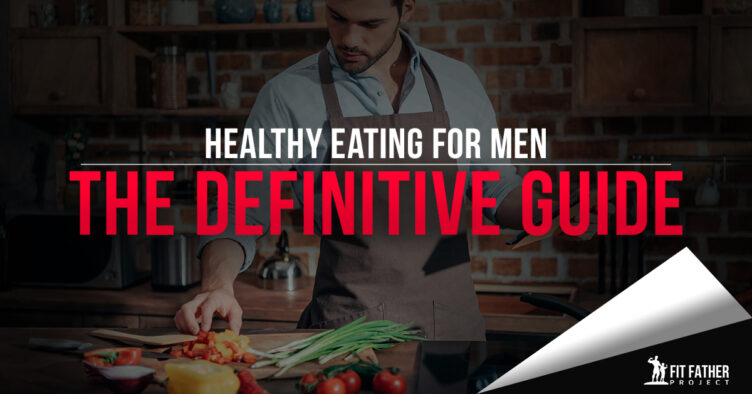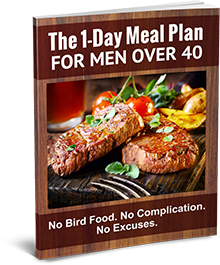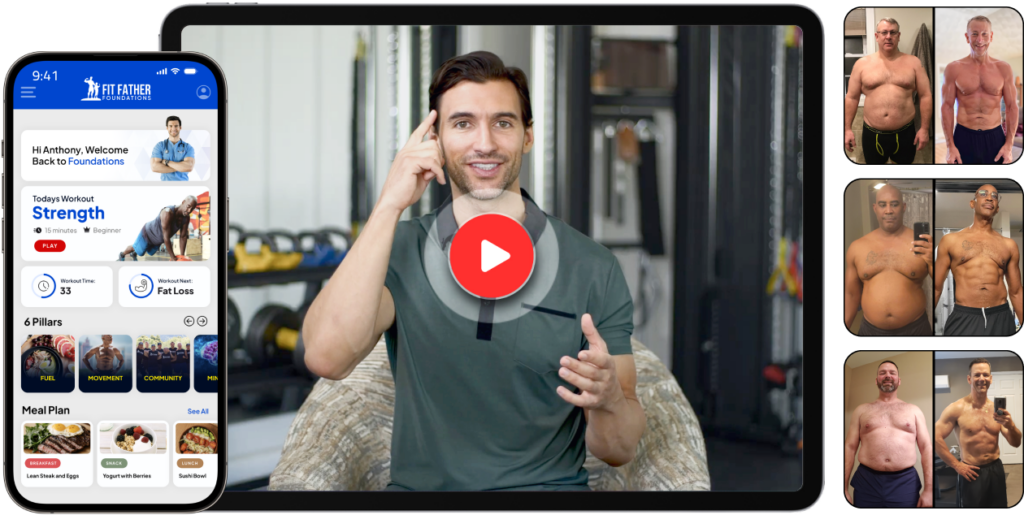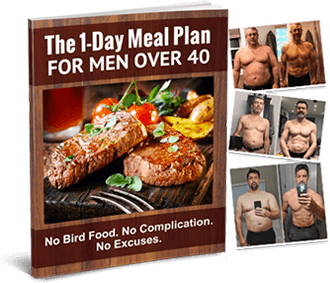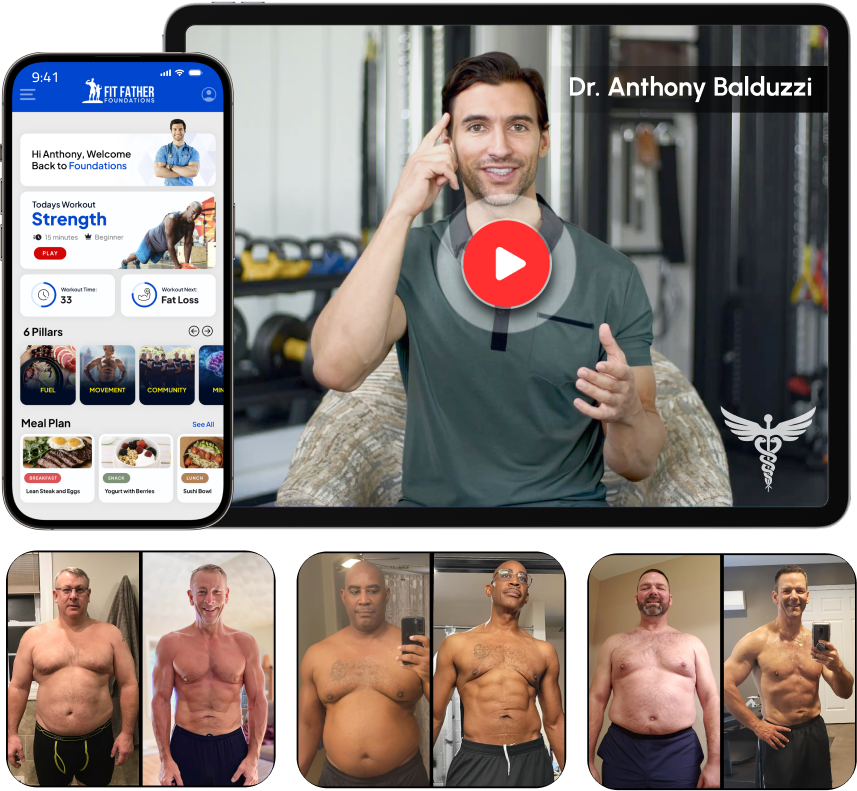Healthy eating for men involves a lot more than simply choosing the right foods or counting calories.
That's why we put together this definitive guide to teach you what you REALLY need to know!
Men have unique nutritional needs. Knowing more about them is the key to staying healthy and reducing your risk of becoming overweight, getting sick, or developing a chronic disease.
Got questions about calories, nutrition, and healthy eating? We have answers!
In this definitive guide to healthy eating for men, you'll learn:
-
- Calorie requirements for men of all shapes, sizes, and ages.
-
- Macronutrient and micronutrient needs.
-
- Fluid needs.
-
- Foods to choose and avoid.
-
- Other ways to improve wellness.
-
- And more!
But before we get into all that, I want you to watch this short video. It will show you a simple method that makes it easier to always eat healthily and stay on track with your diet!
Welcome To The Fit Father Project – Your New Nutrition and Workout Resource!
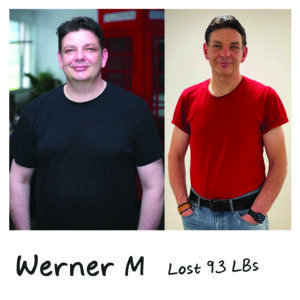
At the Fit Father Project, we specifically help busy men over 40 get back in shape by offering free information and resources on our website, backed up with our Fit Father 30X (FF30X) Program.
This article will teach you everything you need to know about healthy eating for men, but we're here to help you make a whole slew of healthy and sustainable lifestyle changes that will last.
Everything we do here at the Fit Father Project aims to simplify eating and exercise for you, so you can get in great shape and stay strong and healthy for your family — without any unnecessary complications.
Sound good? Good. Let's dive in!
Calorie Requirements for Men
Men often require more calories than women for numerous reasons. They are often taller, weigh more, have more muscle mass, and have a higher metabolism. Because of this, men also need more protein, vitamins, minerals, and fiber than women.
The Dietary Guidelines for Americans recommend the following general energy guidelines for weight management in men:
- Ages 19-20: 2,600-3,000 calories
- Ages 21-35: 2,400-3,000 calories
- Ages 36-40: 2,400-2,800 calories
- Ages 41-55: 2,200-2,800 calories
- Ages 56-60: 2,200-2,600 calories
- Ages 61-75: 2,000-2,600 calories
- Ages 76 and older: 2,000-2,400 calories
These recommendations are general guidelines for healthy weight maintenance, but everybody is different. The more active you are and the more muscle mass you have, the greater your calorie needs.
If weight loss is your goal, the National Heart, Lung, and Blood Institute (NHLBI) suggests men need about 1,500-1,800 calories per day to lose weight at a safe and effective rate of 1-2 pounds per week. You might need more or less than this to achieve safe weight loss, depending on your size, body composition, physical activity level, and metabolism.
A good rule of thumb is to reduce your current energy intake by 500-1,000 calories per day (or burn off 500 extra calories daily through exercise) to drop about 1-2 pounds of body fat weekly. Avoid losing more than 5 pounds per week unless your doctor supervises you.
Macronutrient Needs
The three main macronutrients include carbohydrates, protein, and dietary fat, which are nutrients your body needs on a daily basis to stay energized and function properly.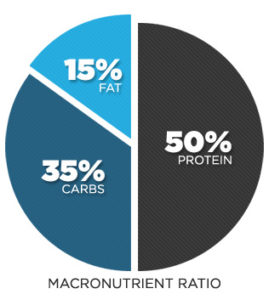
According to the Food and Nutrition Board, men have the following minimum daily macronutrient needs:
- Carbohydrates: 130 grams, or 45-65% of your calorie intake
- Fiber: 30-38 grams per day for men
- Protein: 56 grams, or 10-35% of your calorie intake
- Fat: 20-35% of your total calorie needs
- EPA plus DHA: at least 500 milligrams per day
Common sources of carbohydrates, protein, and dietary fat are as follows:
Carbohydrate-Rich Foods (about 15 g of carbs per serving)
Carb-rich foods that contain about 15 grams of carbohydrates per serving include whole-grain bread, whole-grain cereal, brown rice, wild rice, and whole-grain pasta. Other high-carb options include fruit, milk, yogurt, plant yogurt, plain kefir, sweet potatoes, peas, corn, black beans, lentils, and other dried beans.
Lower-Carb Foods (about 5 grams of carbs per serving)
Examples of foods containing lower amounts of carbohydrates include lettuce, spinach, kale, other leafy greens, tomatoes, cucumbers, bell peppers, mushrooms, celery, carrots, asparagus, zucchini, broccoli, cauliflower, onions, and green beans. Additional options are Greek yogurt, plant milk, almonds, cashews, pistachios, pecans, hazelnuts, peanuts, pine nuts, walnuts, Brazil nuts, macadamia nuts, and nut butter.
Protein-Rich Foods
Examples of healthy protein-rich foods include lean organic meat, chicken, turkey, duck, fish, shrimp, scallops, crab, other types of seafood, eggs, tofu, and seitan. Additional sources of protein include nuts, seeds, nut butter, milk, yogurt, kefir, cheese, peas, beans, lentils, and other legumes. Protein powder, protein shakes, and protein bars are also excellent sources of protein.
Micronutrient Requirements
Micronutrient (vitamins and minerals) requirements for healthy men are as follows:
Vitamins
- Vitamin A: 900 micrograms per day
- Vitamin C: 90 milligrams per day
- Vitamin D: 15-20 micrograms per day
- Vitamin E: 15 milligrams per day
- Vitamin K: 120 micrograms per day
- Thiamin: 1.2 milligrams per day
- Riboflavin: 1.3 milligrams per day
- Niacin: 16 milligrams per day
- Vitamin B6: 1.3-1.7 milligrams per day
- Folate: 400 micrograms per day
- Vitamin B12: 2.4 micrograms per day
- Pantothenic acid: 5 milligrams per day
- Biotin: 30 micrograms per day
- Choline: 550 milligrams per day
Minerals
- Calcium: 1,000-1,200 milligrams per day
- Chromium: 30-35 micrograms per day
- Copper: 900 micrograms per day
- Fluoride: 4 milligrams per day
- Iodine: 150 micrograms per day
- Iron: 8 milligrams per day
- Magnesium: 400-420 milligrams per day
- Manganese: 2.3 milligrams per day
- Molybdenum: 45 micrograms per day
- Phosphorous: 700 milligrams per day
- Selenium: 55 micrograms per day
- Zinc: 11 milligrams per day
- Potassium: 3,400 milligrams per day
- Sodium: 1,500 milligrams per day
- Chloride: 1.8-2.3 grams per day
Eating a variety of foods from each food group, as well as taking a multivitamin supplement designed for men, is the best way to meet your body's micronutrient needs. If you're deficient in vitamin D, vitamin B12, or other micronutrients, your doctor may recommend you consume higher doses of certain vitamins or minerals from supplements.
Fluid Needs
Drinking plenty of fluids, especially water, is one of the most important things you can do to stay healthy. According to the Food and Nutrition Board, men need 3.7 liters (about 16 cups ) of fluid daily to prevent dehydration and maintain proper body functions.
Consume plenty of milk, plant milk, coffee, tea, or broth-based soups to meet your body's fluid needs, but try to meet most of your fluid requirements by drinking water. Drink 2-4 cups of water when you wake up each morning. If weight loss is your goal, drink 2 cups of water before meals to boost satiety and help you eat fewer calories throughout the day.
Learn how to make your water healthier and SUPERCHARGE it!
How to Plan Healthy Meals for Men
There are several simple strategies you can use to plan meals for healthy eating for men.
Examples include:
Perfect Plate Method
Using our Perfect Plate method is simple and doesn't take much planning. It's basic but effective, and here's everything you need to know about it.
-
- Half of each plate should be vegetables, particularly lower-calorie, non-starchy ones (remember, green is good).
-
- One-fourth of each plate should be nutritious, protein-rich foods (turkey, chicken, lean beef, tuna).
-
- One-fourth of each plate should be fiber-rich carbohydrates (sweet potato, brown rice, quinoa).
Also, be sure to mix in healthy fats at each meal, consume three servings of dairy foods or plant-based alternatives (plant milk or plant-based yogurt) daily, and eat about two servings of fruit each day.
USDA Method
Using the Dietary Guidelines for Americans as a reference, you can measure foods in each food group to plan daily menus. Your personalized USDA meal plan depends on your daily calorie requirements. Use the following meal plans below as a guide:
1,600-Calorie USDA Plan
- Fruits: 1 1/2 cups
- Vegetables: 2 cups
- Grains: 5 ounces
- Protein Foods: 5 ounces
- Dairy Foods: 3 cups
- Oils (healthy fats): 5 teaspoons
2,000-Calorie USDA Plan
- Fruits: 2 cups
- Vegetables: 2 1/2 cups
- Grains: 6 ounces
- Protein Foods: 5 1/2 ounces
- Dairy Foods: 3 cups
- Oils (healthy fats): 6 teaspoons
2,400-Calorie USDA Plan
- Fruits: 2 cups
- Vegetables: 3 cups
- Grains: 8 ounces
- Protein Foods: 6 1/2 ounces
- Dairy Foods: 3 cups
- Oils (healthy fats): 7 teaspoons
2,800-Calorie USDA Plan
- Fruits: 2 1/2 cups
- Vegetables: 3 1/2 cups
- Grains: 10 ounces
- Protein Foods: 7 ounces
- Dairy Foods: 3 cups
- Oils (healthy fats): 8 teaspoons
3,200-Calorie USDA Plan
- Fruits: 2 1/2 cups
- Vegetables: 4 cups
- Grains: 10 ounces
- Protein Foods: 7 ounces
- Dairy Foods: 3 cups
- Oils (healthy fats): 11 teaspoons
To complete your USDA menu, pick and choose foods from the following food groups:
Fruits (1-cup equivalent)
- 1 cup of fresh fruit
- 1 cup of 100% fruit juice
- 1/2 cup of dried fruit
Vegetables (1-cup equivalent)
- 1 cup of fresh or cooked vegetables
- 2 cups of leafy greens
- 1 cup of 100% vegetable juice
- 1/2 cup of dried vegetables
Grains (1-ounce equivalent)
- 1/2 cup of cooked rice
- 1/2 cup of cooked pasta
- 1/2 cup of cooked cereal
- 1/2 cup of cooked quinoa
- 1 medium slice of whole-grain bread
- 1 cup of ready-to-eat cereal
Protein Foods (1-ounce equivalent)
- 1 ounce of lean meat
- 1 ounce of poultry
- 1 ounce of seafood
- 1 egg
- 1/4 cup of tofu
- 1/4 cup of cooked beans
- 1 tablespoon of nut or seed butter
- 1/2 ounce of nuts or seeds
Dairy Foods (1-cup equivalent)
- 1 cup of milk
- 1 cup of plant milk
- 1 cup of yogurt
- 1 cup of plain kefir
- 1 cup of cottage cheese
- 1 1/2 ounces of natural cheese
Oils (1 teaspoon-equivalent)
- 1 teaspoon of plant-based oil
- 1/6th of an avocado
- 8 large lives
- 1/3 ounce of nuts or seeds
- 2 teaspoons of nut butter
You can count nuts, seeds, and nut butter as part of the protein or oils food group.
Don't turn up your nose — find out why liver and other organ meats are fantastic additions to your diet!
Foods to Choose and Avoid
Believe it or not, some formerly “unhealthy” foods might actually be good for you, and vice versa. Knowing which food items to choose at the grocery store and which to avoid can aid in healthy eating for men.
Choose the Following Foods
Choosing a variety of foods from each food group is best when planning meals for healthy eating for men. Pick whole foods that have undergone minimal to no processing.
Organic Meats
While it's often best to limit red meat, choosing grass-fed, fresh, or frozen organic meat is a good choice. Lean beef and other types of lean meat are loaded with protein, zinc, iron, vitamin B12, and other essential vitamins and minerals. Lean beef often contains 20-25 grams of high-quality protein in each 3-ounce portion.
Poultry, Fish, and Seafood
Fresh or frozen chicken, turkey, fish, shrimp, scallops, crab, and other types of seafood make an excellent addition to healthy eating plans for men. These foods are just as high in protein as red meat, containing 20-25 grams in each 3-ounce serving. Avoid highly processed, fried, or breaded poultry, fish, and seafood.
Organic Fruits
Adding a variety of fresh or frozen fruit to your meal plan is an excellent way to boost your fiber and vitamin intake. Go organic whenever possible. If you choose dried fruit, opt for varieties that don't contain any added sugar. Steer clear of fruits canned or packed with syrup or added sugar.
Organic Vegetables
When planning for healthy eating for men, choose a variety of fresh or frozen vegetables (go organic when possible). Pick leafy greens, tomatoes, cucumbers, bell peppers, mushrooms, or other non-starchy vegetables, as well as corn, peas, black beans, lentils, and other starchy veggies. If you have high blood pressure or heart disease and need to limit your sodium intake, avoid canned veggies or choose those with no added salt.
Whole Grains
Add whole grains to your meal plan instead of refined grains like white bread. Pick oatmeal, whole-grain breakfast cereals, brown rice, wild rice, quinoa, whole-grain bread, whole-grain pasta, whole-grain couscous, or other whole grains.
Nuts, Seeds, and Natural Nut Butters
Add nuts, seeds, and natural nut butter to healthy eating plans for men. Doing so adds fiber, heart-healthy fats, protein, vitamins, and minerals to your menu. If you need to limit sodium, choose unsalted nuts or seeds. Avoid nut butter that contains added sugar.
Extra Virgin Plant Oils
Adding plant-based oils to recipes is an excellent way to incorporate heart-healthy fats into your meal plan and boost satiety. Many of these oils are rich in brain-boosting omega-3 fatty acids. Choose extra-virgin plant oils whenever possible, as they are often the healthiest (minimally processed) option.
Here’s A Free Weight Loss Meal Plan For Busy Men 40+
Discover exactly what to eat for breakfast, lunch, and dinner to lose belly fat & feel energized 24/7 without hard dieting...
Avocados
Avocados are an excellent source of heart-healthy fats, fiber, and vitamins. They boost satiety, which can curb junk food cravings. Add avocados to soups, salads, stir fry, other entrees, or even smoothies!
Olives
Like avocados, olives are a good source of heart-healthy fats. You can add olives to just about any dish, especially soups, salads, and other main dishes.
Organic Dairy Foods
Adding dairy foods to your diet contributes protein, calcium, vitamin D, phosphorous, and numerous other vitamins and minerals. Choose milk, Greek yogurt, plain kefir, cottage cheese, cottage cheese, or natural cheeses. While general guidelines use to encourage low-fat dairy foods, new studies show the benefits of choosing higher-fat or even full-fat dairy products. Some researchers found that high-fat dairy foods don't contribute to obesity, heart disease, or diabetes – and may even lower your risk of developing these conditions!
Herbal Seasonings
Rather than flavoring food with salt or condiments containing added sugar, consider using your favorite herbal seasonings instead – especially if you must limit your sodium intake because of high blood pressure or heart disease.
Coffee and Tea
Studies show that caffeine in coffee and tea can boost your body's metabolism (energy expenditure) and enhance fat burning. These drinks are very low in calories, containing about 5 calories (or less) in each serving. Drink coffee or tea in the morning or early afternoon, but avoid consuming it late in the day so you can get a good night's sleep.
Low-Sugar Protein Bars
Choose protein bars between meals or when you're on the go. Make sure the bars you pick are low in added sugar and preservatives. Or, consider nutritious homemade protein bars!
Natural Protein Powders
Consider adding whey, casein, egg, peanut, pea, or other plant-based protein powders to homemade shakes or smoothies. Doing so can curb satiety between meals. You can replace meals with protein shakes if weight loss is your goal. Avoid protein powder containing added sugar or artificial sweeteners whenever possible. Mix protein powder with unsweetened almond milk plus fruit or nut butter if you'd like!
Is that healthy food really healthy? Learn how to read nutrition labels properly and what nutrition facts REALLY mean.
Avoid the Following Foods
When healthy eating for men is your goal, avoid certain foods and drinks whenever possible.
Fried Foods
Picking foods that are baked, grilled, or roasted is usually the healthiest option. Breaded, fried foods add extra calories and carbohydrates to your menu. Instead of fried chicken, chicken-fried steak, fried shrimp, or fried cheese curds, choose baked chicken or turkey, grilled steak, grilled shrimp, or regular cheese.
Processed Meats
Eating processed meat can increase your risk of developing certain types of cancer, according to the American Cancer Society. Processed meat gets transformed through smoking, curing, fermentation, salting, or other processes that enhance or preserve its flavor. Examples of processed meats to steer clear of whenever possible include bologna, ham, hot dogs, sausage, bacon, and deli meats.
Poor Quality Red Meat
It's best not to overdo it when it comes to eating red meat, but certain types of meat are healthier than others. In addition to avoiding processed meats, steer clear of fatty cuts of red meat and red meat containing hormones or antibiotics. If you eat red meat, choose organic, grass-fed varieties when possible.
Sugar-Sweetened Drinks
You probably already know that sugar-sweetened drinks aren't the healthiest choice, as studies show these drinks increase your risk of weight gain, type 2 diabetes, and heart disease. Sugar-sweetened beverages contain empty calories from added sugar, which makes it difficult to maintain a healthy weight. Avoid soda, sweet tea, lemonade, sugary sports drinks, and sugar-sweetened juice drinks. Instead, pick water, unsweetened plant milk, coffee, or unsweetened tea.
Diet Foods and Drinks
While it's true that many diet foods and drinks are lower in fat and calories than non-diet foods, they aren't the best option. Studies have linked artificial sweeteners (calorie-free sweeteners) with higher body weights and metabolic diseases. Diet foods and drinks might taste sweet, but artificial sweeteners they contain don't contribute to satiety. Furthermore, they may cause you to crave sweets and other junk food.
Refined Grains
Refined grains are made from whole grains, but they lose fiber and other nutrients during processing. For this reason, whole grains offer many nutritional benefits over refined grains. Avoid highly processed grains when possible. Examples of grains to steer clear of include white bread, white rice, regular pasta, white bagels or tortillas, many baked goods, and sugar-sweetened cereals.
Here are the 9 worst health habits that most people do every day — and how to stop them!
Other Ways to Improve Wellness
In addition to healthy eating for men, there are several things you can to do boost your body's immune system and your overall health and wellness.
Take Dietary Supplements for Men
Adding dietary supplements to your meal plan is an excellent way to stay healthy and reduce your risk of illness and disease. Even if you eat healthy foods, sometimes you don't get enough of the essential nutrients your body requires daily. If your doctor says it's OK, dietary supplements for men to consider include:
- Testosterone-boosting supplements
- Fish oil supplements
- Protein shakes or bars
- Probiotics supplements
- Fiber supplements
- Metabolism-boosting supplements
- Extra vitamin D
The supplements that are best for you depend on your dietary intake and whether or not you struggle with nutritional deficiencies or chronic diseases.
Get Regular Exercise
Regular exercise complements healthy eating plans for men. Getting plenty of physical activity reduces your risk of unwanted weight gain, helps your body eliminate toxins through sweating, increases your muscle mass/fat ratio, and gives your metabolism a boost. Choose a good balance of strength training and aerobic workouts to maximize health benefits and improve your body composition.
Sleep More
Getting sufficient sleep each night is one of the best things you can do for your body. Doing so enhances your immune system and helps control your appetite.
Studies show that sleep deprivation (getting less than 7 hours of sleep per night) is associated with a higher body mass index (BMI) and an increased risk of obesity. Sleep deprivation can alter hunger hormone levels, causing you to feel hungrier.
Get a good night's sleep by setting a regular bedtime, not going to bed hungry or very full, and sleeping in a cool, dark room. Try meditation or reading a book before bed but avoid blue light (screen time).
Improve your sleep quality at night with these 5 ways to sleep better!
Try Stress-Relieving Strategies
Stress can increase inflammation and your risk of sleeping problems or unwanted weight gain. To keep stress levels low, get regular exercise, spend time outdoors, and try yoga, tai chi, meditation, massage, or being spiritual. Take a mental health day off from work when you need to.
Weigh in Daily
Whether your goal is weight loss, muscle gains, or maintaining your current weight, daily weigh-ins are important. Studies show that weighing in daily is highly effective for healthy weight management. Set a goal weight and weigh yourself at the same time each day. For example, step on the scale when you first wake up each morning.
Join a Men's Health Program
Whether you're already eating nutritious foods or you'd like motivation to begin healthy eating for men, consider joining a men's health program like the Fit Father Project. Doing so gives you access to custom meal plans, fat-burning and muscle-building workouts, weekly newsletters, motivational support from medical experts, and much more!
Here’s a FREE Meal Plan & Workout For Busy Men 40+
We’ll show you exactly what to eat & how to exercise to reignite your metabolism in your 40’s, 50’s & 60’s.
Special Dietary Considerations
There's no one-size-fits-all meal plan for every man. Consider the following considerations if you're an older adult or have specific dietary needs.
Diet for Diabetes
If you have diabetes, it's important to plan out your meals to control blood sugar and reduce the risk of diabetes-related complications – such as nerve damage, foot problems, heart disease, kidney damage, or eye problems.
Diabetic meal plans vary based on the type of diabetes you have.
It's best to avoid eating too many carbohydrate-rich foods at one time. Space them out throughout the day and eat smaller, more frequent meals instead of just a few very large meals. Focus on protein-rich foods, heart-healthy fats (plant oils, avocados, etc.), and carbohydrate foods high in fiber – especially fruits, vegetables, whole grains, legumes, nuts, and seeds. Limit or avoid sweets, sugary drinks, baked goods, white bread, white rice, and other refined grains.
If you require insulin injections, use them as directed by your doctor or dietitian and plan out your meals accordingly. Test your blood sugar regularly and lose weight if you're overweight or obese. Get plenty of exercise on a daily basis (at least 30 minutes per day) and see your doctor for routine checkups.
Diet for Arthritis
A diet rich in whole foods is best to reduce inflammation if you have arthritis. The Arthritis Foundation recommends following the Mediterranean diet, which is a meal plan rich in olive oil, fish, legumes, vegetables, fruits, nuts, seeds, and whole grains.
Diet for Food Allergies
If you have a food allergy or lactose intolerance, avoid certain foods and ingredients that cause allergic reactions. You may have an allergy to soy-based foods, nuts, wheat, eggs, shellfish, or milk. If you have lactose intolerance, avoid milk and milk products or choose lactose-free milk or plant milk instead of traditional cow's milk. You might be able to better tolerate yogurt, cottage cheese, or hard cheese in small amounts.
Diet for Gluten Intolerance
If you have gluten intolerance or Celiac disease, avoid foods containing wheat, rye, barley, triticale, and oats processed in the same facility as these gluten-containing grains. Foods you can include in a gluten-free diet are fruits, vegetables, beans, other legumes, nuts, seeds, eggs, fish, poultry, most dairy foods, and lean (organic when possible) red meat. Examples of grains that don't contain gluten include rice, quinoa, millet, some oats, and gluten-free flour. Look for the words “gluten-free” on food labels.
Diet for High Blood Pressure and Heart Disease
If you have high blood pressure or heart disease, follow your doctor's instructions for healthy eating for men. Consume plenty of fruits, vegetables, legumes, whole grains, nuts, and seeds. Choose whole foods over processed foods and limit your sodium intake to 1,500-2,300 milligrams per day, depending on what your doctor recommends. Flavor foods with herbs instead of a salt shaker and check the sodium content on food labels. Get plenty of exercise, reduce stress, don't smoke, and limit or avoid alcohol.
Learn how to determine what a good heart rate for your age is, along with some strategies to measure and manage it.
Diet for High Cholesterol
If you have high cholesterol, follow a diet that's similar to a blood pressure-lowering meal plan. Lose weight if you're overweight and focus on plant-based foods like fruits, vegetables, whole grains, plant-based fats (olive oil, avocados, etc.), legumes, nuts, seeds, and natural nut butter.
Limit or avoid high-fat red meat, processed meat, and other highly processed foods. Choose grilled chicken, turkey, fish, or seafood, plus unsweetened plant milk, cottage cheese, or Greek yogurt. Get regular exercise, don't smoke or drink a lot of alcohol, and take fiber or omega-3 supplements if your doctor recommends it.
Diet for Older Adults
Older adults require fewer calories than younger adults, but they need more of certain nutrients. Examples include calcium, magnesium, vitamin D, and vitamin B6. Eat a healthy, well-balanced diet and take dietary supplements if your doctor asks you to. Get screened for low testosterone, low bone density, colon cancer, prostate cancer, high cholesterol, and high blood pressure as you age.
Diet for Bone Health
To maximize bone health as you age and reduce the risk of osteoporosis and fractures, consume enough calcium, vitamin D, vitamin A, magnesium, phosphorous, and other essential nutrients. Aim to consume at least three 1-cup portions of dairy foods or plant milk each day and take a dietary supplement designed for bone health if your doctor recommends it. Participate in bone-strengthening exercises like jogging, playing basketball, or rope jumping on a regular basis.
Weight Loss Diets
You don't have to severely restrict calories, carbs, or dietary fat to reach your goal weight and maintain it long-term. Healthy weight-loss diets are well-balanced to help you avoid hunger, fatigue, and nutritional deficiencies.
Cutting back on carbohydrates can enhance weight loss, especially if you reduce carbs from refined grains and added sugar. However, carbohydrates are your body's main energy source, and fiber-rich carbs are loaded with essential vitamins and minerals.
Low-fat diets used to be popular, but you don't have to cut back on dietary fat to drop weight. In fact, many weight-loss diets, including ketogenic diets and the Atkins diet, are high in protein and fat. Dietary fat helps boost satiety, is beneficial for heart and brain health, promotes healthy hair, skin, and nails, and enhances the absorption of fat-soluble vitamins.
Erin Coleman is a registered and licensed dietitian with over 15 years of freelance writing experience. She graduated with her Bachelor of Science degree in nutritional science from the University of Wisconsin-Madison, and completed her dietetic internship at Viterbo University in La Crosse, Wisconsin. Prior to beginning her career in medical content writing, Erin worked as Health Educator for the University of Wisconsin-Madison Department of Internal Medicine. Her published work appears on hundreds of health and fitness websites, and she’s currently working on publishing her first book! Erin is a wife, and a Mom to two beautiful children.Erin Coleman, B.S. Nutritional Science, R.D., L.D.
Writer, Fit Father Project
The FOUNDATIONS Program is created by Dr. Anthony Balduzzi for Men 40+ who want Lifelong Health. In just 6-Weeks following FOUNDATIONS, you'll experience: FOUNDATIONS has transformed 60,000 lives! Are you ready to experience true lasting health & results?Join our 6-Week Doctor Designed Health Program. You'll Gain Foundational Health for the Rest of Life.
*Please know that weight loss results & health changes/improvements vary from individual to individual; you may not achieve similar results. Always consult with your doctor before making health decisions. This is not medical advice – simply very well-researched info on healthy eating for men.

